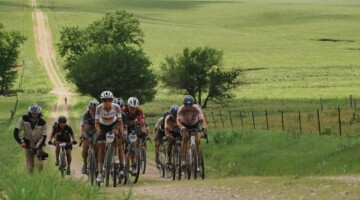However, as they were in Kansas at the Dirty Kanza 200 race that same weekend, flats were difficult to avoid in California as well. Nash joined eventual winner Olivia Dillon in the flat tire club and went on the finish second. “It started off really well, I was in the lead on the first climb, and then I got a flat tire,” Nash told Cyclocross Magazine after the race.
[caption id="attachment_119768" align="aligncenter" width="1140"]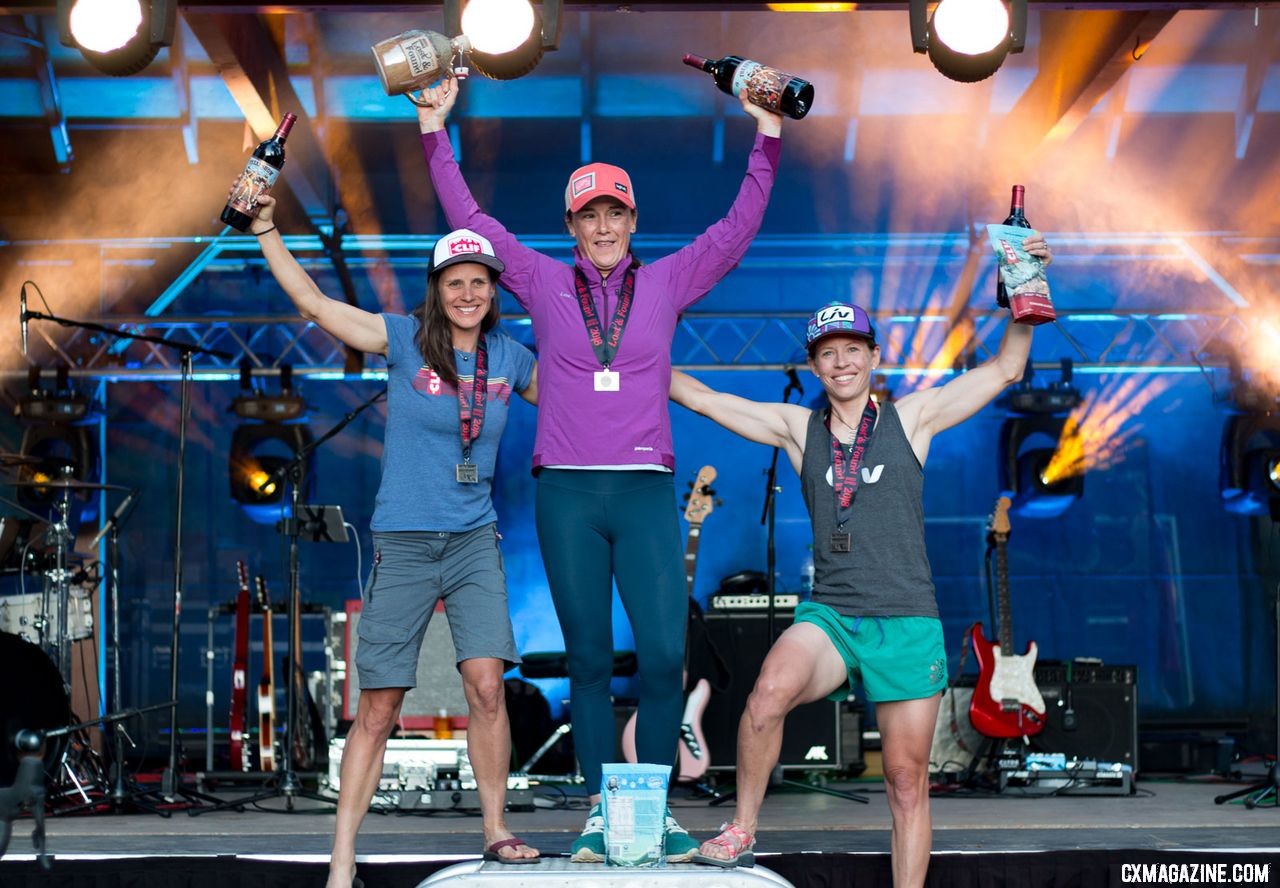 Nash finished second at the 2018 Lost and Found gravel race. © Cyclocross Magazine[/caption]
Nash finished second at the 2018 Lost and Found gravel race. © Cyclocross Magazine[/caption]
Despite her impressive performance, Nash said she has only ridden her gravel bike a “couple times earlier this year,” with the Sagan Dirt Fondo near her Truckee home last month being one of those occasions. Lost and Found is also close to home for Nash, and she used the race as a training opportunity and a chance to support racing in her backyard.
[caption id="attachment_120318" align="aligncenter" width="1140"]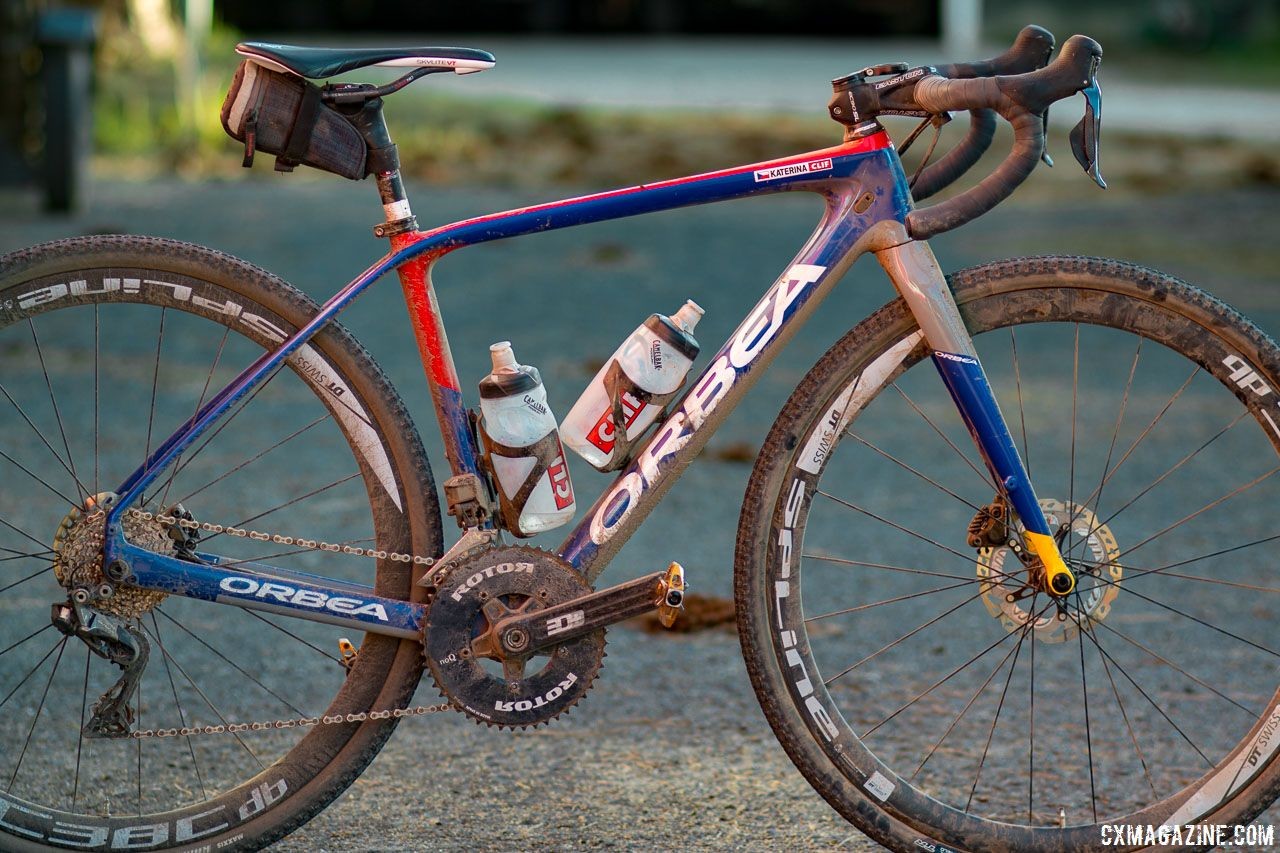 Katerina Nash’s carbon Orbea Terra gravel bike. 2018 Lost and Found gravel race. © Cyclocross Magazine[/caption]
Katerina Nash’s carbon Orbea Terra gravel bike. 2018 Lost and Found gravel race. © Cyclocross Magazine[/caption]
Nash and her Clif Pro Team teammates rode Ibis bikes during the past several seasons, but Nash hinted the team would have a new bike for 2018 when we spoke with her at the 2018 U.S. Cyclocross Nationals in Reno.
The new bike is the Orbea Terra, which is the same model in name as Nash rode prior to the 2014 season (see our profile of that bike here), albeit with cantilever brakes. Read on for a profile of Nash’s updated Orbea Terra from this year’s Lost and Found Gravel Grinder.
Back to the Future for Nash
Riding an Orbea bike is nothing new for Katerina Nash. Prior to the team’s switch to Ibis-branded bikes in 2014, the then Luna Pro Team rode the Orbea Terra frame during the cantilever brake era. As we noted in our profile of her rebranded Ibis Hakkalugi, the team switched in part because it wanted a cyclocross bike with disc brakes.
The Terra is still Basque-based Orbea’s cyclocross and gravel frame, but it has since modernized it with disc brakes and more. Orbea redesigned the platform in 2017 to include flat mount disc brakes, 12mm thru-axles, hidden fender mounts and clearance for tires up to 40mm wide. The frame also incorporates swappable cable stops to allow internal routing of both mechanical and electronic shifting cables.
The cyclocross/gravel Terra frame has a 70.5-degree head tube angle, and Nash’s Small frame has a chainstay length of 43cm and wheelbase of 103cm. “It’s a great bike for gravel,” Nash said. That’s consistent with Orbea’s positioning of the bike, with words like “explore,” “straying from the beaten path,” “all road,” and of course, “gravel.”
[caption id="attachment_120321" align="aligncenter" width="1140"]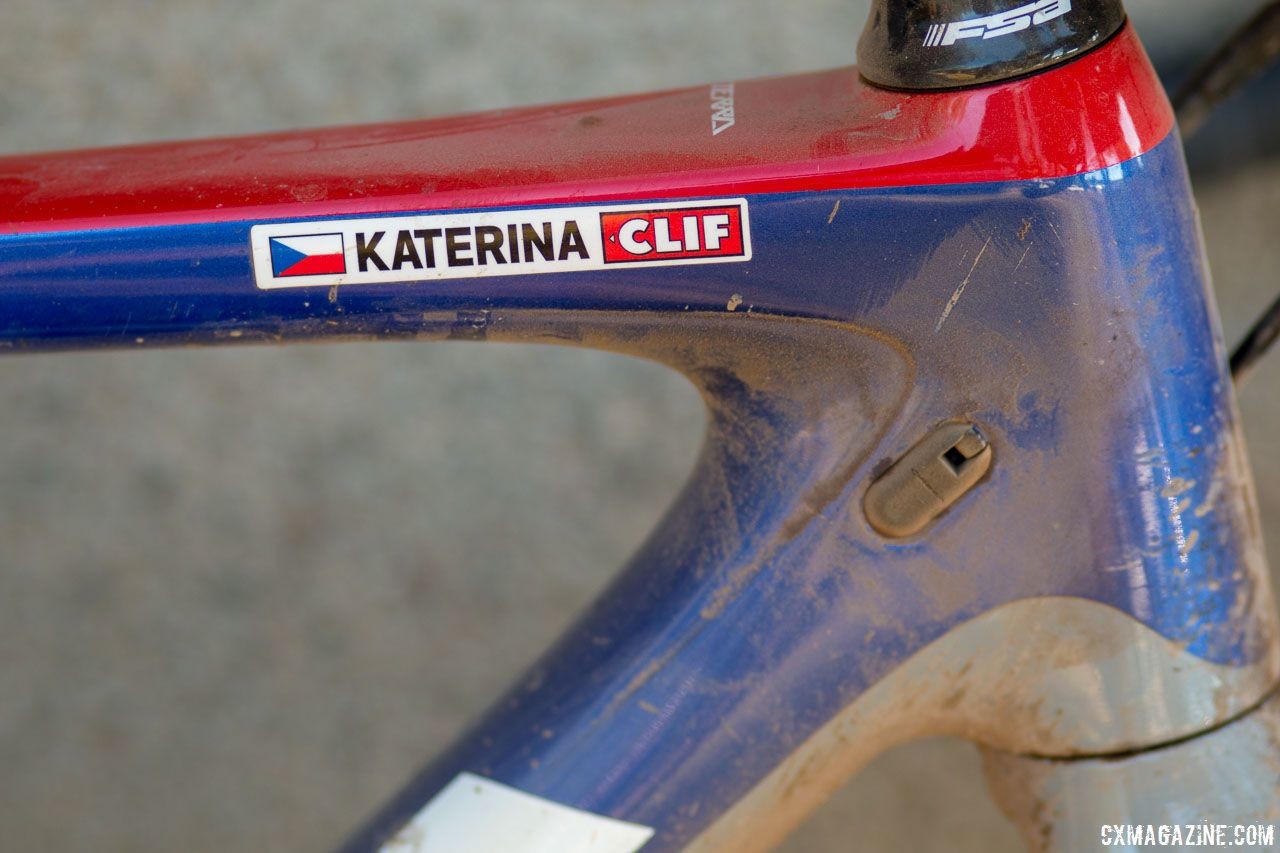 The Terra features increasingly common replaceable cable stops to run a variety of mechanical and electronic drivetrains. Katerina Nash’s carbon Orbea Terra gravel bike. 2018 Lost and Found gravel race. © Cyclocross Magazine[/caption]
The Terra features increasingly common replaceable cable stops to run a variety of mechanical and electronic drivetrains. Katerina Nash’s carbon Orbea Terra gravel bike. 2018 Lost and Found gravel race. © Cyclocross Magazine[/caption]
Nash equipped the bike with a Shimano Dura-Ace R9150 Di2 transmission with ST-R9170 shift/brake levers. Her derailleurs were Dura-Ace R9150, and her hydraulic calipers were Dura-Ace BR-R9170 that bit onto Shimano RT-99 XTR Centerlock rotors, 160mm front, 140mm rear. We saw Sven Nys run the new clutch-based Ultegra RX805 rear derailleur at the DK200, but Nash stuck with the top-end Dura-Ace non-clutch model.
Keeping with the frame’s Spanish origins, Nash chose a Rotor 3D+ crankset and NOQ chain rings in a 50/34t combination. She applied power with Crankbrothers Candy 11 pedals.
[caption id="attachment_120320" align="aligncenter" width="1140"]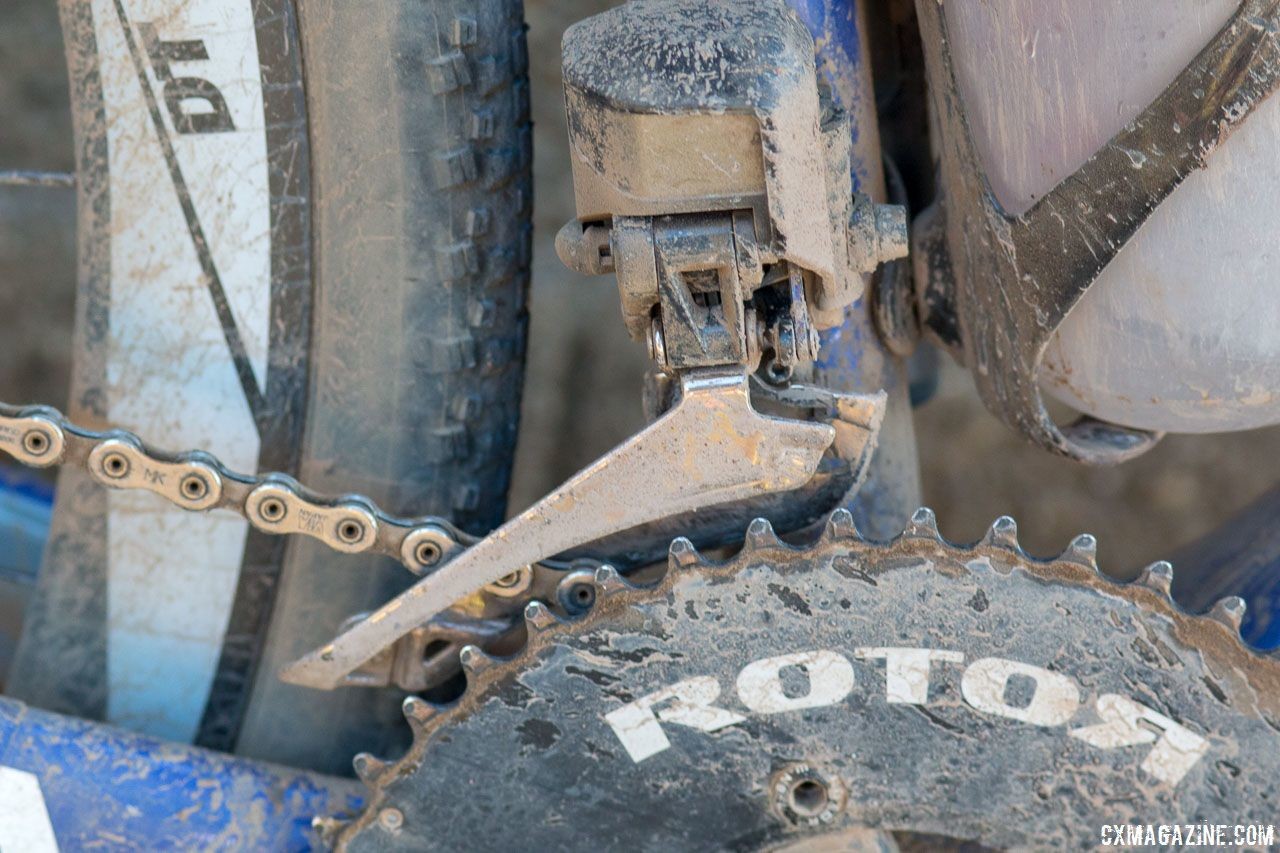 Nash chose what appeared to be 50/34t compact chain rings, which are on the steeper side for gravel. Katerina Nash’s carbon Orbea Terra gravel bike. 2018 Lost and Found gravel race. © Cyclocross Magazine[/caption]
Nash chose what appeared to be 50/34t compact chain rings, which are on the steeper side for gravel. Katerina Nash’s carbon Orbea Terra gravel bike. 2018 Lost and Found gravel race. © Cyclocross Magazine[/caption]
Easton provided Nash with her cockpit, supplying an EC90SL stem and matching handlebar as well as an EC90 carbon seat post which held her Astute Skylite VT carbon-railed saddle in place. She used a K-Edge Garmin mount integrated into her headset spacer stack to hold her computer.
Nash rolled on DT Swiss RC-38C DB carbon wheels, the tubeless clincher version of the wheels Gage Hecht rode to Pan-Ams glory in Louisville. For the conditions at hand in California, Nash chose Maxxis Rambler tires in 700c x 38mm with the company’s EXO casing that is the lighter of the two casings offered for the Rambler. Nash inflated her tires to the “upper 30s” in psi but was unable to provide an actual number due to a malfunctioning pressure gauge.
[caption id="attachment_120330" align="aligncenter" width="609"]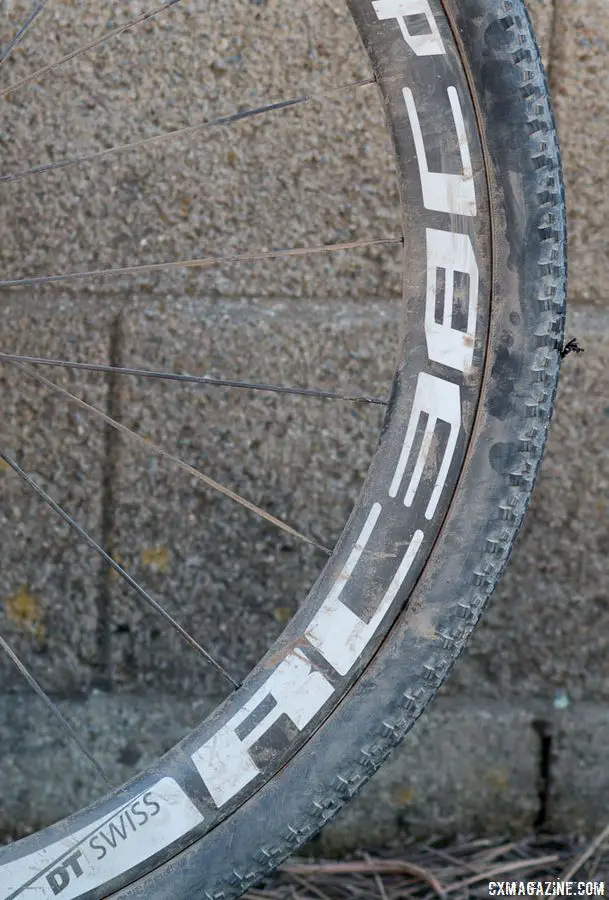 DT Swiss RC 38 wheels are an older model but remain in use with cyclocross pros. They were available in tubular and tubeless clincher variants. Katerina Nash’s carbon Orbea Terra gravel bike. 2018 Lost and Found gravel race. © Cyclocross Magazine[/caption]
DT Swiss RC 38 wheels are an older model but remain in use with cyclocross pros. They were available in tubular and tubeless clincher variants. Katerina Nash’s carbon Orbea Terra gravel bike. 2018 Lost and Found gravel race. © Cyclocross Magazine[/caption]
As mentioned above, Nash suffered a gashed tire during the race. She tried patching it and reinflating it with CO2 cartridges, but eventually had to settle for adding a tube and inflating it with a hand-pump to get home.
[caption id="attachment_120331" align="aligncenter" width="1140"]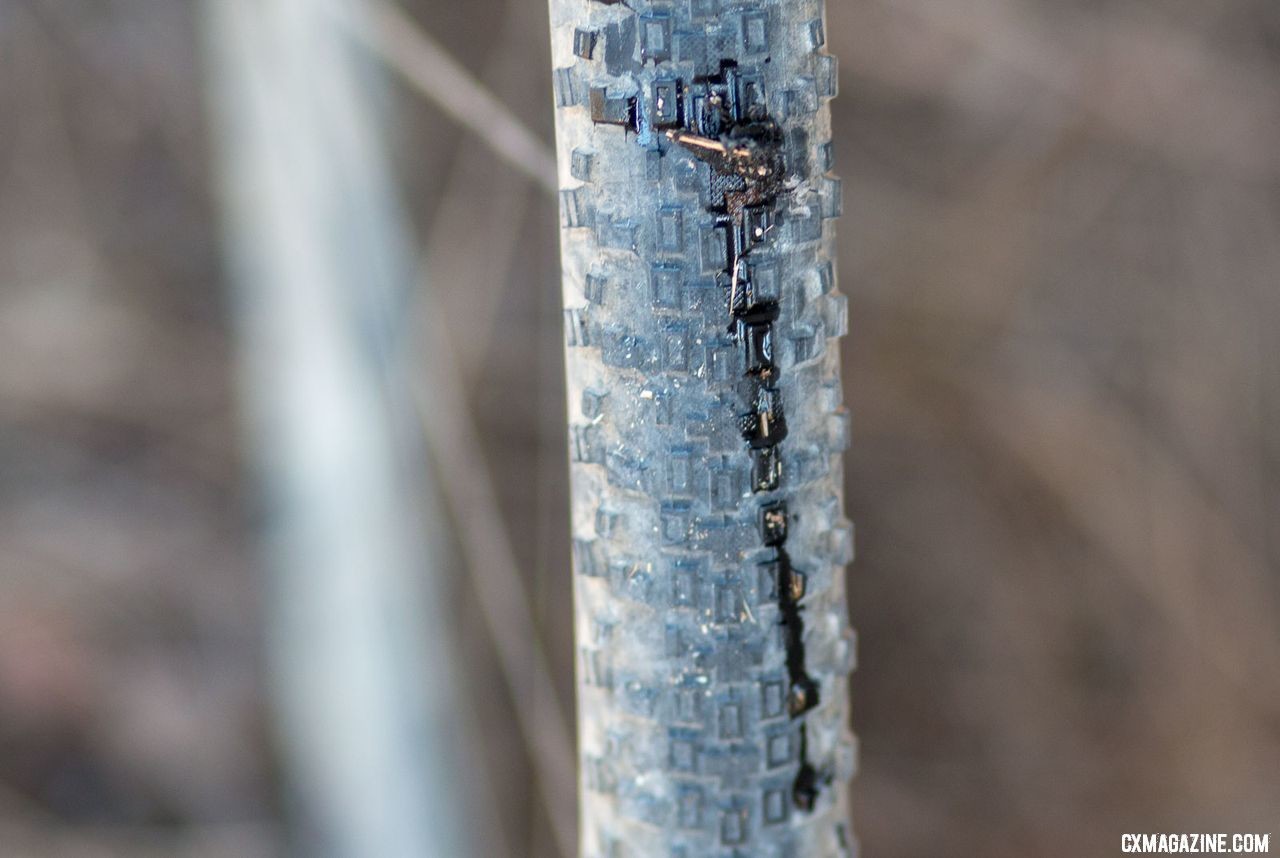 Katerina Nash attempted to plug her cut in the Maxxis Rambler tire but had to eventually resort to a tube. 2018 Lost and Found gravel race. © Cyclocross Magazine[/caption]
Katerina Nash attempted to plug her cut in the Maxxis Rambler tire but had to eventually resort to a tube. 2018 Lost and Found gravel race. © Cyclocross Magazine[/caption]
Nash’s confirmed she will not be riding an Ibis this cyclocross season, but was not certain what her new ride would be. We saw three of the four winners that Saturday at Lost and Found and Dirty Kanza 200 win on bikes aimed at cyclocross racing. Might Nash and the Clif Bar Pro Team go full circle by competing in cyclocross on bikes aimed at gravel and prove many bikes can do both really well?
With the cyclocross season less than three months away, we will find out soon enough.
See the photo gallery and specs below for a closer look at Nash’s Lost and Found Orbea Terra.
For more gravel bikes, see our profiles of Olivia Dillon’s Specialized Diverge, Kaitie Keough and Ted King’s Cannondale SuperXes, Sven Nys’ Trek Checkpoint, Tobin Ortenblad’s Santa Cruz Stigmata, Rowie Jaron’s custom titanium NTP Bikes gravel bike and Craig Richey’s Devinci Hatchet.
Katerina Nash’s Lost and Found Orbea Terra Gravel/Cyclocross Bike

























